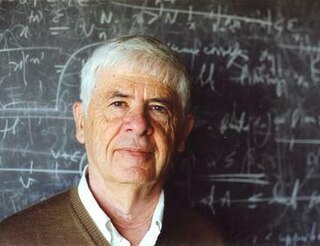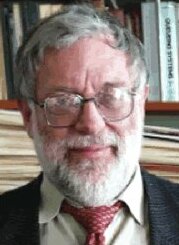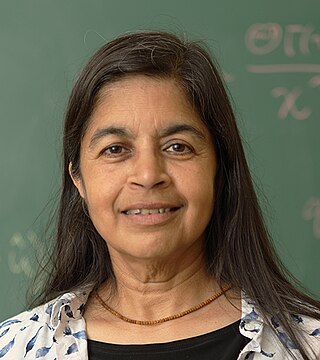Related Research Articles
The Association for Computing Machinery (ACM) is a US-based international learned society for computing. It was founded in 1947 and is the world's largest scientific and educational computing society. The ACM is a non-profit professional membership group, reporting nearly 110,000 student and professional members as of 2022. Its headquarters are in New York City.

The Courant Institute of Mathematical Sciences is the mathematics research school of New York University (NYU). Founded in 1935, it is named after Richard Courant, one of the founders of the Courant Institute and also a mathematics professor at New York University from 1936 to 1972, and serves as a center for research and advanced training in computer science and mathematics. It is located on Gould Plaza next to the Stern School of Business and the economics department of the College of Arts and Science.
Society for Industrial and Applied Mathematics (SIAM) is a professional society dedicated to applied mathematics, computational science, and data science through research, publications, and community. SIAM is the world's largest scientific society devoted to applied mathematics, and roughly two-thirds of its membership resides within the United States. Founded in 1951, the organization began holding annual national meetings in 1954, and now hosts conferences, publishes books and scholarly journals, and engages in advocacy in issues of interest to its membership. Members include engineers, scientists, and mathematicians, both those employed in academia and those working in industry. The society supports educational institutions promoting applied mathematics.
Mark Sebastian Wainwright is an Australian chemical engineer and emeritus professor of the University of New South Wales, and institutional leader within the Australian academic and technological sectors. He served as seventh vice chancellor and president of the UNSW from 2004 to 2006. In 2004 he was appointed a member of the Order of Australia for services to chemical engineering as a researcher and academic, and to tertiary education. In 2007 he was awarded an honorary doctorate of science by the University of New South Wales. He was born 20 Oct.,1943.

Alexandre Joel Chorin is an American mathematician known for his contributions to computational fluid mechanics, turbulence, and computational statistical mechanics.

Charles Edward Miller Pearce was a New Zealand/Australian mathematician. At the time of his death on 8 June 2012 he was the Elder Professor of Mathematics at the University of Adelaide.
Ian Hugh Sloan AO is an Australian applied mathematician.
Renfrey Burnard (Ren) Potts AO (1925–2005) was an Australian mathematician and is notable for the Potts model and his achievements in: operations research, especially networks; transportation science, car-following and road traffic; Ising-type models in mathematical physics; difference equations; and robotics. He was interested in computing from the early days of the computing revolution and oversaw the first computer purchases at the University of Adelaide.
The George Szekeres Medal is awarded by the Australian Mathematical Society for outstanding research contributions over a fifteen-year period. This award, established in 2001, was given biennially in even-numbered years until 2021 and has since been given annually, for work that has been carried out primarily in Australia

Nalini Joshi is an Australian mathematician. She is a professor in the School of Mathematics and Statistics at the University of Sydney, the first woman in the School to hold this position, and is a past-president of the Australian Mathematical Society. Joshi is a member of the School's Applied Mathematics Research Group. Her research concerns integrable systems. She was awarded the Georgina Sweet Australian Laureate Fellowship in 2012. Joshi is also the Vice-President of the International Mathematical Union, and is the first Australian to hold this position.
Arieh Iserles is a computational mathematician, currently Professor of the Numerical Analysis of Differential Equations at the University of Cambridge and a member of the Department of Applied Mathematics and Theoretical Physics.
Sir Thomas MacFarland Cherry F.A.A., F.R.S. was an Australian mathematician, serving as Professor of Mathematics at the University of Melbourne from 1929 until his retirement in 1963.
Michael J. Shelley is an American applied mathematician who works on the modeling and simulation of complex systems arising in physics and biology. This has included free-boundary problems in fluids and materials science, singularity formation in partial differential equations, modeling visual perception in the primary visual cortex, dynamics of complex and active fluids, cellular biophysics, and fluid-structure interaction problems such as the flapping of flags, stream-lining in nature, and flapping flight. He is also the co-founder and co-director of the Courant Institute's Applied Mathematics Lab.
Michelle Louise Coote FRSC FAA is an Australian polymer chemist. She has published extensively in the fields of polymer chemistry, radical chemistry and computational quantum chemistry. She is an Australian Research Council (ARC) Future Fellow, Fellow of the Royal Society of Chemistry (FRSC) and Fellow of the Australian Academy of Science (FAA).
Yvonne Marie Stokes is an Australian mathematician whose research involves fluid mechanics, mathematical biology, and industrial applications of mathematics. She is a professor and Australian Research Council Future Fellow at the University of Adelaide.
Frances Y. Kuo is an applied mathematician known for her research on low-discrepancy sequences and quasi-Monte Carlo methods for numerical integration and finite element analysis. Originally from Taiwan, she was educated in New Zealand, and works in Australia as a professor in applied mathematics at the University of New South Wales.
Michael G. Eastwood is a mathematician at the University of Adelaide, known for his work in twistor theory, conformal differential geometry and invariant differential operators. In 1976 he received a PhD at Princeton University in several complex variables under Robert C. Gunning. He was a member of the twistor research group of Roger Penrose at the University of Oxford and he coauthored the monograph The Penrose Transform: Its Interaction with Representation Theory with Robert Baston. After moving to South Australia in 1985 he was the 1992 recipient of the Australian Mathematical Society Medal and made a Fellow of the Australian Academy of Science in 2005. In 2012 he was named to the inaugural (2013) class of fellows of the American Mathematical Society.
Kerry Anne Landman is an Australian applied mathematician, known for her cross-disciplinary research. Over her research career she established and led collaborations across engineering, industry and biological fields. In 2007, she became the first woman professor in the School of Mathematics and Statistics at the University of Melbourne. She retired in 2015 and is now an Emeritus Professor at the University of Melbourne.
Jacqui Ramagge is Executive Dean of the Faculty of Science at Durham University and Honorary Professor of Mathematics at the University of Sydney. She was born in London, emigrated to Australia in 1991, and returned to the UK to take up the position at Durham University in 2020.
Jennifer A. Flegg is an Australian mathematician and is a Professor of applied mathematics in the School of Mathematics and Statistics at the University of Melbourne.
References
- ↑ About us, www.austms.org.au
- ↑ "Election of officers and ordinary members of Council" (PDF). Gazette of the Australian Mathematical Society. 47 (2). 2020.
- ↑ "Office Bearers – Australian Mathematical Society" . Retrieved 15 August 2020.
- ↑ "Australian Mathematical Society (AustMS)". Cambridge Core. Retrieved 15 August 2020.
- ↑ "ANZIAM Journal". journal.austms.org.au. Retrieved 15 August 2020.
- ↑ About us, ANZIAM, www.anziam.org.au
- ↑ "ANZIAM : Awards". www.anziam.org.au. Retrieved 15 August 2020.
- ↑ "ANZIAM : Cherry Ripe Prize". www.anziam.org.au. Retrieved 15 August 2020.
- ↑ "ANZIAM : Special Interest Groups". www.anziam.org.au. Retrieved 15 August 2020.